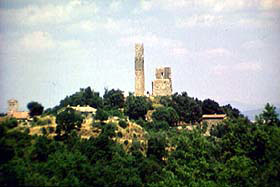Crevole Castle
 |
 |
| The tower of Crevole with the scarce rests of the keep enclosure. | |
Crevole rises to north of the town of Murlo, principal center of the area. It can be reached following the SS2 Cassia and from here the indications for Lucignano d' Arbia. From the SS223 Siena-Grosseto following the indications for Fontazzi.
The area where the castle of Crevole rises is today the territory of the town of Murlo. During medieval times it was involved in one of the principal fiefs of the Bishop of the nearby powerful city of Siena. This was granted in 1189 and already at the end of the same century the Episcopalian dominion of the area was total so much so that it constituted one of his greatest patrimony. From the year 1274, also maintaining full powers during the fief, the bishops were subjected to the obligation of militia and from 1387 to the payment of tribute to the Senese Commune. Only in 1749 the laws of the bishop on Murlo and its territory were abolished. The only evidence of its long history under ecclesiastical hegemony is the nearby town of Vescovado whose name is derived from the Italian word "Vescovo" which means bishop.
Although the already named country of Murlo was the chief town of the fief another important residence of the bishop was Crevole Castle. It already existed at the moment of the constitution of the privileges but subsequently magnified and mostly strengthened for better serve the demands of the new important owner. In the first years of the XIV� century the bishop Malavolti strengthened the structure again. The garrison of the castle was Sienese but employed by the gentleman of the fief . Siena tried to obtain control over the castle at the end of the 14th century. The most important military involving Crevole was also the last action of its existence: during the war of Siena the imperial troops leveled to the ground the fortification. Of the once important castle encircled by double curtain walls and with many towers, today remains only the square tower on the highest point of the hill (presumably the original nucleus of the first small fortress), part of the walled enclosure of the keep and some sections of the surrounding external walls. Totally abandoned until few years ago the complex belongs to an agri-touristic estate and the scarce remains have been consolidated.
| Back to Homepage |
| Back to Castles Index |